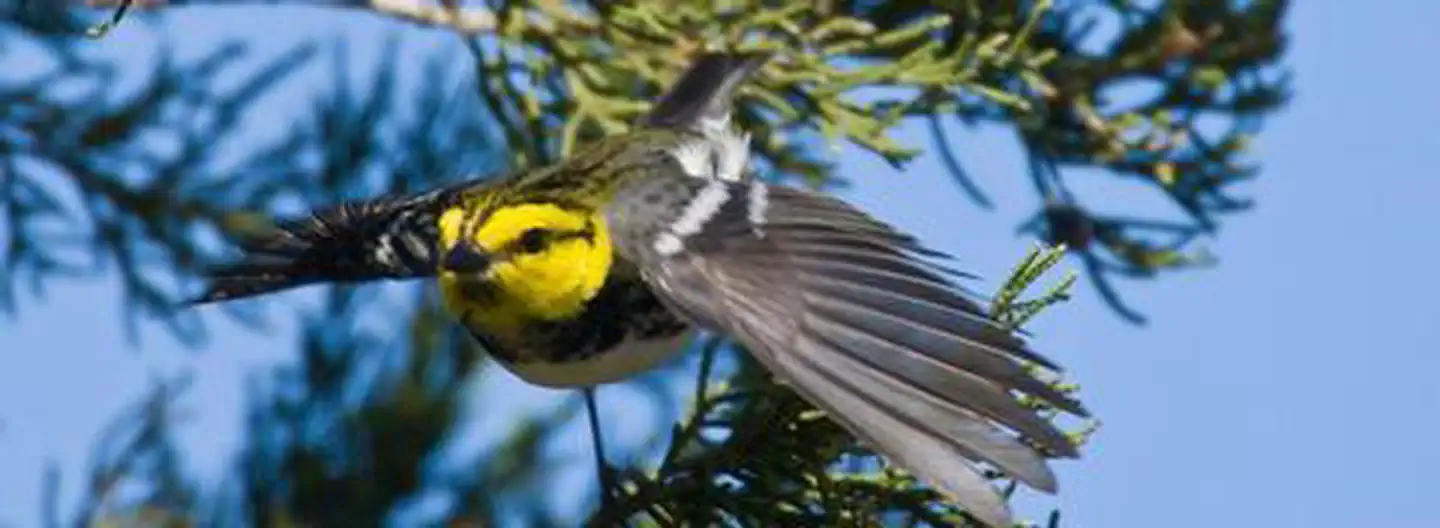Balcones Canyonlands National Wildlife Refuge
Overview
Balcones Canyonlands National Wildlife Refuge is managed by Fish and Wildlife Service and is located near Marble Falls, Texas.
This rugged terrain has spared old Ashe juniper and oak woodlands from logging and shelters some of the best golden-cheeked warbler habitat. The Brazos tributaries to the north cut only shallow canyons. Here, the refuge foothills ease into savannahs where the open country supports oak shinneries (head-high thickets) vital to the black-capped vireo. These songbirds and their rapidly diminishing habitats are why Balcones Canyonlands National Wildlife Refuge was established in 1992.
Both the endangered golden-cheeked warbler and the recently de-listed black-capped vireo share a common problem. They depend on very specialized habitats to make a living, and those places grow fewer by the day in the wake of development and human activity. That's why this refuge has a critical role to play in both preserving and restoring their homes.
Beneath the homes of songbirds lies a mysterious world of caves, rivers and sinkholes called "karst." Over time, naturally acidic water dissolved the limestone and sculpted a labyrinth inhabited by night creatures. Ringtail cats and raccoons retreat into cave entrances for shelter. Cliff chirping frogs and whitethroat slimy salamanders squeeze into moist crevices. Cave crickets and daddy longlegs live within caves, but leave to feed and return. Some spiders, beetles and pseudoscorpions never come out to the light, living all their lives in reclusive darkness. Still deeper lies the Trinity Aquifer, the source of many Central Texas springs and beautiful Hill County rivers. These same rivers eventually flow into the marshes, estuaries and bays along the Texas coast.
But here on the refuge, well above the surface, the deep, clear-water pools are not only important sources of water for wildlife during a drought, they are often the last refuge for the hardy fish that remain. An occasional flash flood will sweep through wiping out much of the vegetation but the standing sycamore, elm, oak and hackberry trees that remain provide important habitat for many wildlife species, including many migratory birds.
The refuge harbors 245 bird species for part or all of the year. Almost half are neotropical migratory birds that breed in the U.S. and winter south of the border. Because of its importance to birds, this refuge is officially designated a Globally Important Bird Area (IBA), meaning that it is a significant site for world bird conservation. The American Bird Conservancy recognized Balcones Canyonlands National Wildlife Refuge as an IBA for its significant role in conserving the golden-cheeked warbler, the black-capped vireo, and their habitats.
Things to Do at Balcones Canyonlands National Wildlife Refuge
Recreation Activities
Popular activities at Balcones Canyonlands National Wildlife Refuge include:
Nearby Activities
- Archery
- Birding
- Hiking
- Hunting
- Interpretive Programs
- Photography
- Picnicking
- Wildlife Viewing
Plan Your Visit
Getting There
Since there are no fees required to visit, you don’t have to start at our visitor information center, but if you’d like to speak with a ranger head to our headquarters office. It’s located 5 miles west of Lago Vista on Farm to Market (FM) 1431 in Marble Falls. This location is closed on weekends and federal holidays, so if you plan to arrive on one of those days, just head to our public areas that are open 365 days a year:
Warbler Vista is located at 21646 ½ E. FM 1431 Lago Vista, TX 78654. If you are coming from the Austin area take Highway 183A to the exit for Whitestone Blvd. (aka FM 1431). Head west on FM 1431 and the entrance is on the north side of the road about 1.5 miles past Lago Vista.
Driving from Warbler Vista to Doeskin Ranch (or vice versa) is a lovely 20 minute drive on scenic Cow Creek Road/County Road 328. You cannot enter the refuge from Cow Creek Road.
Doeskin Ranch is located at 10645 FM 1174 Bertram, TX 78605. If you are coming from the Austin area, take Highway 183A to Highway 29 and turn west. Take Hwy 29 for 3 miles and turn left (west) on Ranch Road 1869. Take RR 1869 for 10 miles until it ends at RR 1174, where you will turn left (south). The entrance to Doeskin Ranch will be 2.5 miles on your left (east).
The Shin Oak Observation Deck is just around the corner from Doeskin Ranch. Leaving the Doeskin Ranch parking lot, make a right (north) and drive 2.5 miles to RR 1868 and make a right (east). Continue for 1.5 miles and turn right (south) into the parking lot for the Shin Oak Observation Deck. Note that there is only an observation deck at this location, there are no trails or restrooms.
GPS Coordinates: 30.50698420000000, -98.02422000000000
Contact & Resources
Phone: 512-339-9432
Additional Information:
